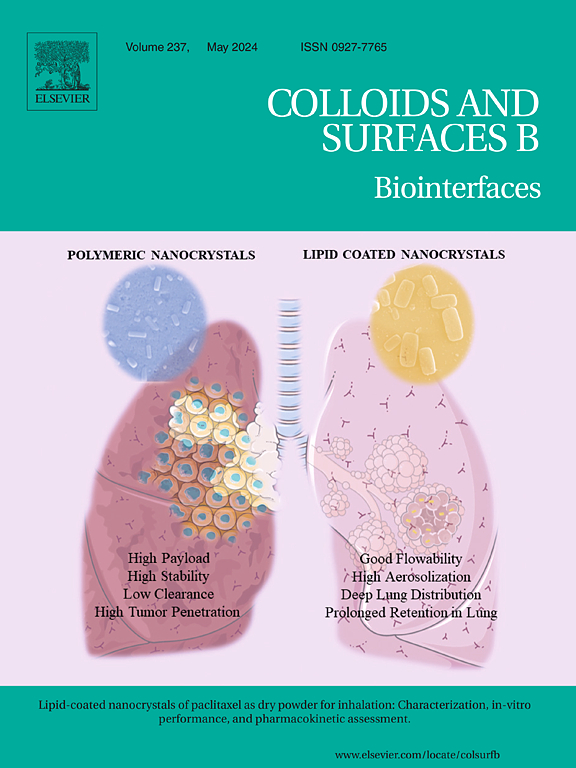不同化学清创剂对钛牙种植体早期细胞反应的影响:基于转录组的种植体周围组织再生的体外研究
IF 5.4
2区 医学
Q1 BIOPHYSICS
引用次数: 0
摘要
背景:种植体周围健康状况不佳会导致生物膜积累、种植体周围炎和骨质流失。化学清创可能有助于维持种植体周围的健康,但其对种植体周围细胞的影响尚不清楚。方法采用过氧化氢(H2O2)、Poloxamer、H2O2 +Poloxamer、Perisolv和parolex 5种清洗剂对钛(Ti)表面进行清洗。小鼠前成骨细胞(MC3T3-E1)、人牙龈成纤维细胞(HGF)和人骨髓基质细胞(hBMSC)在试剂处理的Ti表面上培养120 分钟,以评估形态学、细胞毒性、粘附性和增殖。对hBMSC进行RNA测序。结果除波洛沙姆外,其他治疗均能抑制细胞扩散。parax增加细胞毒性,抑制细胞增殖。Perisolv破坏hBMSC粘附并不同程度地影响增殖。单独使用H2O2或与Poloxamer联合使用H2O2可提高hBMSCs的细胞毒性并抑制粘附,但对MC3T3-E1或HGF没有作用。相比之下,poloxmer处理的Ti表面增强了所有细胞类型的粘附和增殖。RNA测序显示,基于氧化剂的处理(H2O2、H2O2 +Poloxamer、Perisolv)抑制了增殖(HMGA2、JAG1、NOTCH1、YAP1、TBX3)、抗凋亡(MCL1、BCL2L2)和粘附(ITGA2、ITGB3、SPP1)的关键基因,同时抑制了MAPK、PI3K-Akt和多能途径。结论Perisolv和Paroex等商业药物损害hBMSC功能,其中Paroex表现出明显的细胞毒性。H2O2具有毒性,特别是对hBMSCs。波洛沙姆促进细胞附着和生长。鉴于这些发现,仔细选择清创剂对于平衡清洁效果和细胞相容性至关重要。对hBMSCs的不良影响需要在应用后立即去除。需要进一步研究支持组织再生的生物材料,以恢复种植体周围的健康。本文章由计算机程序翻译,如有差异,请以英文原文为准。
Impact of different chemical debridement agents on early cellular responses to titanium dental implants: A transcriptome-based in vitro study on peri-implant tissue regeneration
Background
Poor peri-implant health leads to biofilm accumulation, peri-implantitis, and bone loss. Chemical debridement may help maintain peri-implant health, but its effects on peri-implant cells remain unclear.
Methods
Five cleaning agents—hydrogen peroxide (H2O2), Poloxamer, H2O2 +Poloxamer, Perisolv, and Paroex—were applied on titanium (Ti) surfaces. Mouse pre-osteoblasts (MC3T3-E1), human gingival fibroblasts (HGF), and human bone marrow stromal cells (hBMSC) were cultured on agent-treated Ti surfaces for up to 120 minutes to assess morphology, cytotoxicity, adhesion, and proliferation. RNA sequencing was performed on hBMSC.
Results
Except for Poloxamer, all treatments inhibited cellular spreading. Paroex increased cytotoxicity and inhibited proliferation. Perisolv impaired hBMSC adhesion and variably affected proliferation. H2O2, alone or with Poloxamer, elevated cytotoxicity and inhibited adhesion in hBMSCs but not MC3T3-E1 or HGF. In contrast, Poloxamer-treated Ti surfaces enhanced adhesion and proliferation across all cell types. RNA sequencing revealed that oxidant-based treatments (H2O2, H2O2 +Poloxamer, Perisolv) suppressed key genes for proliferation (HMGA2, JAG1, NOTCH1, YAP1, TBX3), anti-apoptosis (MCL1, BCL2L2), and adhesion (ITGA2, ITGB3, SPP1), while inhibiting MAPK, PI3K-Akt, and pluripotency pathways.
Conclusion
Commercial agents like Perisolv and Paroex impair hBMSC function, with Paroex demonstrating significant cytotoxicity. H2O2 exhibits toxicity, particularly to hBMSCs. Poloxamer improves cell attachment and growth. Given these findings, careful selection of debridement agents is critical to balance cleaning efficacy and cytocompatibility. The adverse effects on hBMSCs necessitate prompt removal postapplication. Further research on biomaterials supporting tissue regeneration postdebridement is needed to restore peri-implant health.
求助全文
通过发布文献求助,成功后即可免费获取论文全文。
去求助
来源期刊

Colloids and Surfaces B: Biointerfaces
生物-材料科学:生物材料
CiteScore
11.10
自引率
3.40%
发文量
730
审稿时长
42 days
期刊介绍:
Colloids and Surfaces B: Biointerfaces is an international journal devoted to fundamental and applied research on colloid and interfacial phenomena in relation to systems of biological origin, having particular relevance to the medical, pharmaceutical, biotechnological, food and cosmetic fields.
Submissions that: (1) deal solely with biological phenomena and do not describe the physico-chemical or colloid-chemical background and/or mechanism of the phenomena, and (2) deal solely with colloid/interfacial phenomena and do not have appropriate biological content or relevance, are outside the scope of the journal and will not be considered for publication.
The journal publishes regular research papers, reviews, short communications and invited perspective articles, called BioInterface Perspectives. The BioInterface Perspective provide researchers the opportunity to review their own work, as well as provide insight into the work of others that inspired and influenced the author. Regular articles should have a maximum total length of 6,000 words. In addition, a (combined) maximum of 8 normal-sized figures and/or tables is allowed (so for instance 3 tables and 5 figures). For multiple-panel figures each set of two panels equates to one figure. Short communications should not exceed half of the above. It is required to give on the article cover page a short statistical summary of the article listing the total number of words and tables/figures.
 求助内容:
求助内容: 应助结果提醒方式:
应助结果提醒方式:


